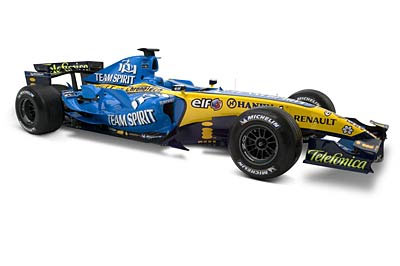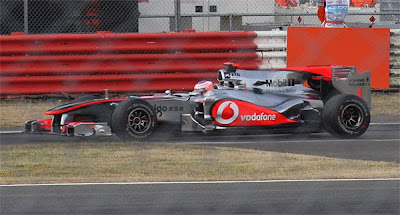Triumph. Triumph over adversity, indecision and inclemency. Triumph over rain,
Bahrain. Triumph over difficult beginnings. Triumph for Jenson Button and Formula 1, that was the story of the Australian Grand Prix 2010. The spiritual season-opener delivered all that Sakhir did not; excitement, unpredictability and specifically, frequent overtaking. Everywhere you looked, there was a story, whether it was Sebastian Vettel’s Red Bull denying him yet another straightforward victory, the three-star world champion sandwich at turn 1 on the first lap, a stirring charge through the field by Lewis Hamilton and Fernando Alonso, or even the assured drive of a man once again on the rise, Robert Kubica.
Qualifying had seen Red Bull lock out the front row, with Vettel claiming his 2nd pole in a row. Home favourite Mark Webber, having not had a smooth run through the second sector on his flying lap, lined up second just ahead of Alonso who had put in an excellent performance. The rest were a quite significant amount behind, most notably Lewis Hamilton who had no excuse apart from a lack of pace and eventually fuel for qualifying 11th, over half a second behind McLaren teammate Button. Rosberg again got the better of Schumacher while making it clear to the media he was unhappy and capable of much better. Rubens Barrichello, Robert Kubica and Adrian Sutil all put in quality laps to overshadow their stable mates and make Q3. Elsewhere, Lotus appeared to have moved ahead of Virgin as the fastest of the new teams, with Sauber looking more and more like pre-season’s biggest sponsor hunters.
Colder temperatures than expected during qualifying in Melbourne turned out to be an occasion of portent, with all teams having to start the race on intermediate tyres. The rain was not expected to last with a dry line forming early on, but of course it would have its effect on the race outcome. Vettel got away from pole cleanly, but the best start was Felipe Massa’s vaulting him past Button, Alonso and Webber into 2nd place. Alonso himself had a diabolical start from 3rd, leaving him surrounded by turn 1. The resulting collision as he turned in on Button caused him to spin, clatter into Schumacher and leave him facing the wrong way. While Fernando sat there for a few painful seconds as the whole field went by, Robert Kubica had gone from 9th to 4th by avoiding the carnage ahead, whereas Schumacher had to pit for a new wing.
The first lap also saw a horrifying crash lead to the season’s first safety car as Kamui Kobayashi’s front wing came off, got caught under his front wheels and sent him careering into the wall. His subsequent rebound threw him back on track and into Sebastien Buemi and Nico Hulkenburg whose races were done on the spot. The sleek new Mercedes SLS safety car pulled in at the end of lap 4, leaving Vettel to resume his lead from Massa, Webber, Kubica, Rosberg, Button, Hamilton, Sutil, Barrichello and De La Rosa. By lap 6 it was clear Jenson was uncomfortable with his car, and he was passed by an on-fire Hamilton, leading to Button pitting at the end of lap 6 for slicks. He then proceeded to go off the road at turn 3, making his decision look premature and losing him a hatful of seconds. However, as soon as he collected himself, Button confirmed his masterstroke and started to set blistering sector times, signalling the need for the rest of the grid to also run slicks which they started doing by the finish of lap 9.
Webber, who had passed a struggling Massa for 2nd, pitted later than most and lost considerable track position as a result. He rejoined 5th, and after a short trip across the grass once again ended up behind Massa who himself had a slow tyre stop due to pit lane traffic. By this point, Button had scythed his way through the field on his warmer slicks using his knowledge of where the grip lay. He now ran 2nd behind Vettel but ahead of Kubica and Rosberg. Come lap 16, Fernando Alonso had fought his way through the pack and was once again running 8th and in the points, but Michael Schumacher had gotten caught up behind Jaime Alguersuari’s Toro Rosso. Lap 16 also saw both Webber and Hamilton pass Massa, then as Hamilton tried to pass Webber on the approach to turn 3, both ran wide and allowed the Ferraris of Massa and Alonso through. This wouldn’t be the last time Lewis and Mark would cause trouble for each other.
The on-track action and intrigue was fast banishing the memories of Bahrain two weeks previous, and even more so when Hamilton passed Massa on lap 22 and Webber got the better of Alonso as the Spaniard got offline between turns 3 and 4 losing a lot of grip and traction. As if there wasn’t enough to keep track of at the front, the biggest shock (or was it?) of the afternoon came as leader Vettel was pitched off the track with suspected wheel/brake failure. The resulting yellow flags had stopped Nico Rosberg from reclaiming the 4th place he’d just lost to the charging Hamilton. All of this left last year’s winner, Button, well ahead of Kubica who himself had maintained position after a superb first part of the race. Hamilton soon caught him and Webber once again dispatched Massa. Alonso had closed up to Massa as well but the threat of imminent team orders did not materialise, and Alonso failed to find a way past for the rest of the afternoon despite once again clearly having the legs on his teammate.
Another major turning point in the race came when Webber, Rosberg and Hamilton pitted again for fresh tyres between laps 31 and 35, dropping them considerably back from the fight for second place. Cue Webber joining behind Rosberg and passing him quickly, then Hamilton going off on a still greasy track and letting Webber through but taking him straight back, followed by both drivers trading fastest laps as they closed by almost 2 seconds per lap on the Ferraris. Inevitably they caught the train again, and the visibly difficult Ferraris which were lifting midway through corners due to chronic understeer, were expected to be easy meat for Hamilton and co. What happened next was an untimely reminder of the difficulties faced by the drivers who tried to pass slower cars in Bahrain. In Alonso’s wake, neither Lewis nor Mark could make any further headway and their pace was reduced to that of the Ferraris with their knackered tyres. This in turn led to the faster degradation of Hamilton’s fresher tyres, especially after the punishment meted out to them over the preceding laps.
When Lewis finally had a sizeable run at Alonso down to turn 13 and had gotten alongside, Alonso kept the inside covered. As Hamilton was pushed wide, Webber took a dive up the inside, hit the McLaren’s rear and both ended up in the sandpit. Rosberg, who had been keeping a very close watching brief, was extremely close to getting past Alonso himself immediately after the incident at turn 13 and showed that had Webber and Hamilton not made contact, the latter may well have slid past Alonso into turn 14. As it was though, Alonso’s masterful defending of position ensured 4th place after such a miserable start, with Hamilton and Webber finishing 6th and 9th respectively. Throughout all of this unfolding drama, world champion Button calmly maintained his lead and preserved his 50+ lap old tyres to come through 12 seconds ahead of the Robert Kubica’s 2nd placed Renault, who himself had withstood pressure from McLaren, Ferrari and Mercedes drivers to claim a memorable podium finish and provide further evidence of his pace and good results on temporary circuits, such as Monaco and Montreal.
It’s great for the championship to have the lesser-rated members of the major partnerships get one over on their illustrious rivals so early on. Felipe Massa has cause to be very proud of his 3rd place performance, very much making up for the loss of position to Alonso at Bahrain’s first corner. However, his noticeable lack of pace compared to Alonso during the race in Bahrain when both had passed Vettel, and the gap to him in Melbourne qualifying will not be lost on the returning Brazilian. Similarly at McLaren, this result is a tremendous boost for a team looking to make it back to the front of the grid and a world champion who very few people gave a chance of standing up to Hamilton. Jenson’s early call for slick tyres and his reputed ability to nurse them made the race for him and stood in stark contrast to Hamilton’s barracking of his team for bringing him in a second time. Suddenly Jenson does not look like the awkward new boy trying to infiltrate a tight circle of friends.
Over at Mercedes, Nico Rosberg did a much better job of supplanting Michael Schumacher as the lead driver in the team by once again scoring solid points, even if he never looked a podium threat at any stage despite running 3rd during the early part of the race. Schumacher crawled into 10th place and the points having finally passed Alguersuari (twice) and then Pedro de la Rosa. However much you consider his time away and his age or the new regulations, 10th place is never going to be an acceptable result for Schumacher, a driver for whom satisfactory was often unsatisfactory.
But what of Red Bull, their well supported Aussie hero and their champion-in-waiting? Their blatant speed advantage has not delivered a victory or even a podium. Vettel cannot be faulted, having not put a foot wrong since the opening day of the season, but Webber’s two qualifying hiccups and latest difficult race day performances can only be attributed to himself. This team is starting to drown in a myriad of missed opportunities, be it Webber’s chance to open up some sort of lead on his superstar teammate who has had nothing but heartbreaking, victory-shattering car dramas or the team as a whole failing to capitalise on a clear early season head start. You expect Vettel will sorely miss the possible 50 points when McLaren and Ferrari start to close the gap as the season progresses into Europe.
Red Bull’s aforementioned rivals will be grateful for the victories handed to them on days where their cars were incapable of winning on pace alone. Possibly of greater importance, F1 has earned temporary respite from the acidic criticism levelled at the sport’s new regulations and the dearth of overtaking opportunities with a scintillating spectacle. Of the new teams, Lotus have also earned themselves a shred more credibility by having a solid Heikki Kovalainen bring home his car 13th, achieving another full race distance for the fledgling squad, just as Karun Chandhok brought home his Hispania Racing Team car 5 laps down but in one piece. Triumph.





















